Corgi Toys – Corgi Boxes a History 1956 – 1983
CORGI TOY BOXES – A HISTORY
Corgi Toys from the outset were looking to gain an edge over the competition, in the case of its models it secured that by introducing window glazing, as its advertising boldly stated : Corgi Toys – ‘The Ones with Windows’. Not only did Corgi Toys look to go one better than the competition with its models, but unlike its main competitor Dinky Toys, Corgi made a marketing decision to steal a march on its rivals and supply its models in individual boxes with an illustration of the model inside incorporated into the box design. Dinky Toys initially sold their vehicles in trade packs of six to the retailer, who then in turn sold them on seperately to the customer.
Corgi Toys as we all know, based in Wales, took their name from that breed of Welsh dogs and took the Corgi dog as its logo which was to be found on virtually all of its future packaging.
July 1956 – 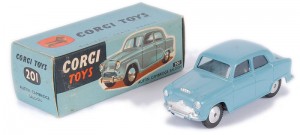 Corgi’s original box design, now commonly referred to as the ‘Blue Box’ simply because that’s exactly what it is. An all blue card box with black lettering in the main along with an identifying illustration of the model it contained.
Corgi’s original box design, now commonly referred to as the ‘Blue Box’ simply because that’s exactly what it is. An all blue card box with black lettering in the main along with an identifying illustration of the model it contained.
These early ‘blue box’ models also came with a concertina leaflet along with an invitation to join the ‘Corgi Club’ by means of an enrolment form.
The card box had two small end flaps and one large ‘tuck-in’ flap to each end on which was printed both the model and its identifying model number.
January 1959 – Introduces us to what is now the iconic Corgi Yellow/Blue box design.
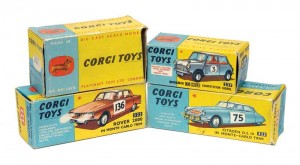 This box design was to last right through until 1966 and again kept things simple with the standard card box as before, but now brought bang up to date with a much more eye catching blue and yellow theme, typical of the early sixties. It also kept with the idea of illustrating the model within by means of a coloured line drawing superimposed over the yellow background yet just pushing into the blue giving the impression of movement. Simple but effective. The artwork was brilliant and was only beaten in my opinion by that of the Airfix models. (No doubt someone will have something to say about that !)
This box design was to last right through until 1966 and again kept things simple with the standard card box as before, but now brought bang up to date with a much more eye catching blue and yellow theme, typical of the early sixties. It also kept with the idea of illustrating the model within by means of a coloured line drawing superimposed over the yellow background yet just pushing into the blue giving the impression of movement. Simple but effective. The artwork was brilliant and was only beaten in my opinion by that of the Airfix models. (No doubt someone will have something to say about that !)
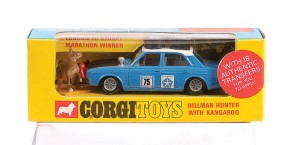 December 1966 – A sad day I have to say as we see the demise of the all card illustrated box as Corgi introduce the first of their ‘Window’ boxes.
December 1966 – A sad day I have to say as we see the demise of the all card illustrated box as Corgi introduce the first of their ‘Window’ boxes.
The previous blue and yellow box colour scheme was retained but now the model was clearly visible through a plastic ‘window’ incorporated into the box design. Initially limited to just a few models but extended to include the full range by 1968. These boxes, now often referred to as the ‘slimline’ boxes, still illustrated the model in artwork form to the rear panel of the box.
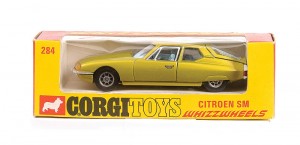
However in 1970 the blue and yellow window boxes for ‘Whizzwheels’ cars changed to red and yellow.
May 1973 – Saw a more drastic change to the box design with the introduction of an angled inner card plinth. 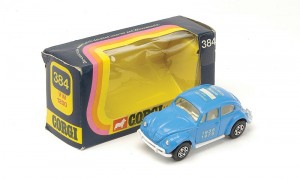 This had the effect of tilting the model towards the front of the box making the box much taller than its ‘slimline’ predecessor.
This had the effect of tilting the model towards the front of the box making the box much taller than its ‘slimline’ predecessor.
The box itself saw a radical change in colour, now a deep blue with three coloured bands around the window which varied from red, orange, yellow, purple or cyan. Sadly gone forever was the glorious Corgi box artwork now replaced on the rear panel with a simple bland photograph of the vehicle contained within.
1981 – Saw yet another revamp with the window box, now changing colour from predominantly blue to yellow, red and black. Black box with broad colour band around the ‘window’, yellow to the front face merging into red to its top face. The box was significantly larger so as to accommodate the model being placed on the skew and mounted on an inner yellow card plinth. For the first time the identifying model number was no longer printed on the outer box, instead the model number and title were printed on the inner plinth. This meant a significant cost saving as the outer box could now be used for several models within the range.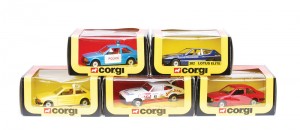
So there you have it … perhaps its my age and I dare say some will disagree with me but to my mind the above represents the gradual decline in the general presentation of the Corgi toy. Not that this is confined just to the Corgi brand in the name of cost saving as most of the major diecast toy companies followed a sad but similar path.

Hi, I’ve been trying to find out what gauge or thickness the Corgi blue boxes should be in order to repair some missing flaps etc. so I can purchase some suitable card, just wondered whether you could help please?
Kind regards
Phil
Hi there Phil, sorry off the top I have to say I don’t know.
I used to own a company that supplied wide format (A0 Size) plan copiers and the supplies that went with them. At that time I was buying and selling toys more as a hobby and was interested in making my own boxes for Dinky and Corgi toys. I got hold of a salesman who supplied us with speciality papers for use with A4 copiers and asked if he could help. What I wanted was a card that was matt white finish on one side to take the image but the correct colour finish on the other side that would match either the Dinky or Corgi ‘internal’ box finish and still be the correct gauge. I gave him a couple of old boxes as samples, It took him a while but eventually he came back with the goods ! If I remember correctly it went on him finding the correct weight of the card initially rather than measuring it by thickness etc. and then trying to find the correct ‘internal’ finish, the matt white not being a problem. Trouble was I had to buy in a quantity of the material, something like 500 sheets at A2 size which would need cutting down to be accepted through a colour printer and then it could only be fed one sheet at a time. in those days A4 Colour Copiers were still in their infancy. STILL WITH ME ? After all that there was still the problem of scanning a good image, I tried buying one of those discs off Ebay that supposedly had all the dinky images scanned on them but the results were poor to say the least.
In my experience most ‘Hobby’ shops just have general card in stock ( white/cream both sides ) what you really need is probably a ‘Design & Print’ outlet but again its doubtful these guys would sell the odd sheet but if you take in an old box they may help out with the gauge or weight.
Bear in mind I’m going back 20+ years so things may well have changed considerably in terms of the products on offer ‘off the shelf’ but I still think your best bet would be running it past a small print outfit for their input.
Cheers for now, David.
Hi
Thank you for your very useful information. I’m curious to know why there is a black and sometimes a yellow plinth for the same models such as the The Saint Jaguar.
Many thanks
Martin
Hi there Martin,
Corgi Return of the Saint Jaguar XJS.
As you say the model can be found in a Corgi ‘window box’ with either a yellow or black inner plinth.
Although in each case the models were numbered 320 there were slight differences both to the model itself and to the box design as well as the inner plinth.
In both cases the model came in white colourway finish, red interior, grey plastic aerial and white base.
The black inner card tray came in a 1978 issue striped pictorial window box and ‘The Saint’ lettering in yellow with red background to header card and end flaps. The Jaguar model was fitted with deep dish chrome hubs.
The yellow inner card tray came in a 1979 issue striped pictorial window box and ‘The Saint’ lettering in this case was red with a white outline to bot the header card and end flaps. The Jaguar model being fitted with 12-spoke chrome hubs.
From experience the black plinth version is by far the most commonly found version of the two although it seems to make very little difference to the value.
Hope that clears thing up for you.
All the best, stay safe, David.